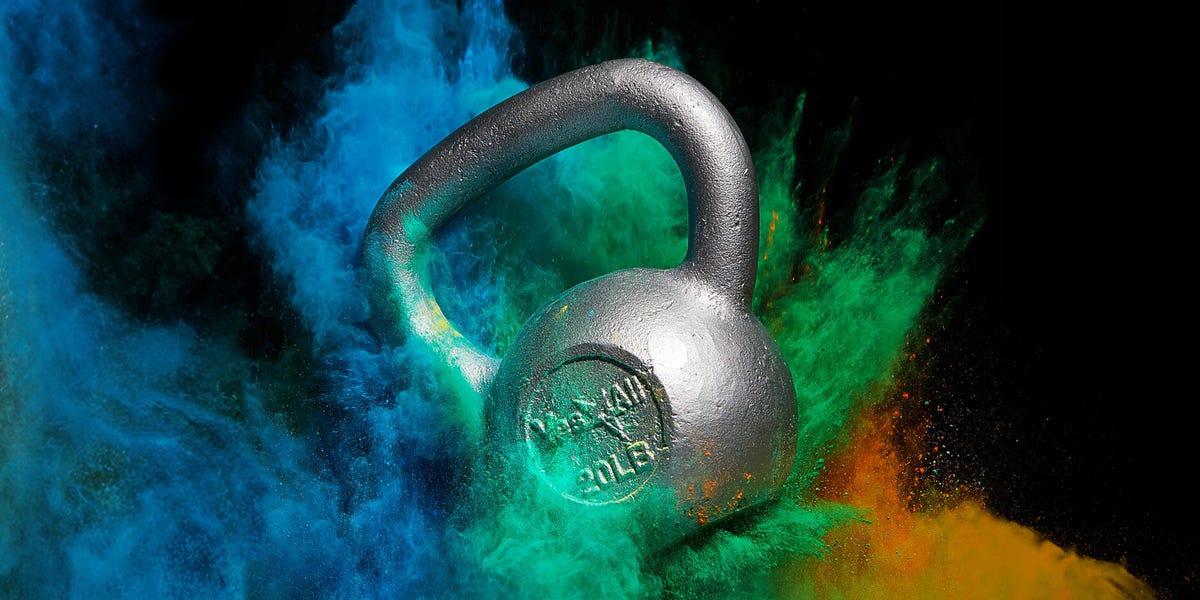If you’ve spent any time on FitTok lately, chances are you’ve landed on videos of women doing 100 kettlebell swings a day in an effort to burn fat and sculpt their muscles. The challenge, which went viral in April thanks to TikTok creator @fit_with_kettlebells, is tagged with nearly 31 million posts. It’s simple: Complete 100 kettlebell swings per day for 30 days straight, either all at once, or split up in sets throughout the day.
The hype behind this particular exercise is real: “Kettlebell swings are a powerhouse, full-body move that strengthen the glutes, hamstrings, hips, core, back, and shoulders—and challenge your grip strength—in one fluid movement,” says Lindsey Bomgren, CPT, founder of Nourish, Move, Love. “This strength move will also raise your heart rate for cardiovascular benefits.”
Meet the experts: Lindsey Bomgren, CPT, is the founder of Nourish, Move, Love. Or Artzi, CPT, is the founder of the fitness platform Orriors. Noam Tamir, CSCS, is the founder and CEO of TS Fitness.
Aside from kettlebell training having so many full-body benefits, this challenge has likely also picked up steam because of how accessible it is, with only one piece of equipment needed, says Or Artzi, CPT, founder of the fitness platform Orriors. Plus, “it’s simple, easy to remember, quick to do, and feels hardcore—people love a challenge with a big round number and a time limit,” adds Noam Tamir, CSCS, founder and CEO of TS Fitness.
But is doing 100 reps of this exercise for a month an effective and safe way to lose fat and gain muscle? Ahead, trainers explain what happens to your body when you take on this challenge, and whether to try it.
What Happens To Your Body When You Do 100 Kettlebell Swings A Day For 30 Days
You may see some fat loss.
The main goal of this challenge is to “burn fat” and “tone your body,” according to proponents of it on TikTok. And there could be some truth to that—beginners or people who haven’t been consistent with exercise in the past may see fat loss simply from exercising on a regular basis, Tamir explains.
The exercise volume of the challenge “can spike energy expenditure and help kick start fat loss,” Tamir says. “However, fat loss depends on a lot of variables such as diet, sleep, stress, and overall activity level.” So if you’re someone who’s already strength training daily and eating relatively healthily, the kettlebell challenge may not drastically change your body fat percentage, says Tamir.
You may gain muscular endurance.
When it comes to the muscle-sculpting goal, kettlebell swings aren’t as good for hypertrophy (increase in muscle size) as other exercises like squats and deadlifts are. Most hypertrophy occurs within the six to 12 rep range per set, Artzi says—not 100. However, high reps do build muscular endurance, which helps your muscles sustain exercise for longer periods of time.
But the benefits also depend on the weight of the ‘bell: Using a lighter kettlebell might make 100 swings more cardio-focused, while a heavy kettlebell shifts the workout toward strength and power—and increases the recovery demands, says Artzi. “Of course, ‘light’ and ‘heavy’ are relative to your strength, experience, and body size, but it’s critical to find a load that encourages proper [form],” she says. (More on that later!)
Ultimately, though, because the challenge calls for 100 kettlebell swings—which is a lot all at once and even if you break them up throughout the day—you’re likely not using a weight that’s going to be heavy enough to cause your muscles to grow. Additionally, if your kettlebell weight stays the same throughout the duration of the challenge, you’ll likely hit a plateau from doing the same move over again, Tamir says. (Your body will get used to how challenging this routine is, so your progress will level out.)
However, if you gradually increase the weight of your kettlebell or your reps each week, you may see an increase in muscle strength, says Tamir. That’s because you’re forcing your muscles to adapt to the increased stress—especially the muscles that make up your posterior chain, which includes glutes, hamstrings, and core.
You could get injured.
Lastly, there appears to be a lack of recovery days in this challenge, which is crucial for building strength and muscle, as your muscles need time to repair and adapt. Skipping rest days increases the risk of fatigue, Artzi explains.
Other Potential Benefits From 30 Days Of 100 Kettlebell Swings
All three experts agree that doing 100 kettlebell swings a day can benefit you in the following ways:
- It builds daily movement and consistency.
- It improves overall conditioning and muscular endurance.
- It encourages commitment and discipline.
- It boosts confidence and motivation because you’re setting and completing a challenge.
Drawbacks Of Doing 100 Kettlebell Swings A Day
With high-rep challenges like this one that provide little opportunity for rest, there’s always the potential for injury—especially for people who spend most of their day sitting at a desk who might lack the mobility to perform a proper hip hinge, Artzi explains. Similarly, repeating the same movement daily without variation or rest increases the risk of overuse injuries—even if you’re a more advanced exerciser.
Plus, people who aren’t familiar with kettlebell swings may end up choosing the wrong weight. If it’s too light, you can end up overextending at the top of the movement, which may also set you up for back pain and back injuries, Bomgren says. And if your weight is too heavy—or you’re adding this challenge on top of an existing training routine—you might also get injured, Artzi says.
If this challenge is the only workout you’re doing, you’re using a manageable weight with decent form, and you’re more experienced with kettlebell swings, it can be a decent workout, Artzi explains. But that’s not always the case.
Lastly, kettlebell swings don’t work every muscle equally, and this challenge isn’t a complete workout program by itself, says Bomgren. “For a more balanced fitness routine, you’d have to pair swings with other strength exercises, mobility, and recovery days, too,” she adds.
Whether You Should Do 100 Kettlebell Swings a Day
The cons of this challenge may outweigh the pros unless you have really solid swinging technique and the knowledge of which weight is most appropriate, experts agree.
“I do not recommend doing 100 kettlebell swings a day, but I do recommend learning proper kettlebell swing form and then incorporating them into your weekly fitness routine,” Bomgren says, advising doing three sets of 10 to 15 reps two to three times a week. “I personally add swings to most of my lower-body workouts, especially if I’m targeting my glutes and hamstrings,” Bomgren adds.
When choosing weights, especially if you’re a beginner, Bomgren recommends lifting 5 to 10 percent of your body weight. For instance, if you weigh 150 pounds, you’d use eight- to 15-pound weights (roughly four to seven kilograms). “You can always start with what you have access to and increase weight as you become more skilled in form and technique,” she says.
How To Do A Kettlebell Swing With Proper Form
How to:
- Stand with feet slightly wider than hip-width apart. Hold a kettlebell in front of your body with both hands, arms straight.
- With a slight bend in the knees and a flat back, hinge at the hips and swing the kettlebell back through the legs. Use that momentum to stand and swing the kettlebell out in front of your body, up to shoulder height.
- Thrust the hips forward, and engage the glutes and core as you stand up straight. When the kettlebell hits shoulder height, the knees should be straight and glutes contracted in a full hip extension.
- Allow the kettlebell to swing back down through the legs, while hinging at the hips. That’s 1 rep.
Try This Full-Body Kettlebell Workout
Here’s a sample workout from Bomgren that’s better at building muscle and burning fat:
- Squats (3 sets of 10 reps)
- Push-ups (3 sets of 10 reps)
- Kettlebell swings (3 sets of 10 reps)
- Back rows (3 sets of 10 reps)
While following a fitness challenge of any kind is great for creating a routine and building consistency, this particular one isn’t the most effective for building strength if that’s your goal. Instead, focus on compound lifts that you can make harder over time, such as squats, presses, and rows.
Danielle Zickl is a freelance writer who has 10 years of experience covering fitness, health, and nutrition. She’s a graduate of Ithaca College. You can find her work here on Women’s Health, and in many other publications including PS, SELF, Well+Good, Runner’s World, Outside RUN, Peloton, Men’s Fitness, and more.
Read the full article here




